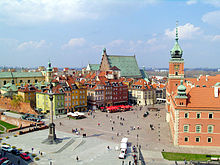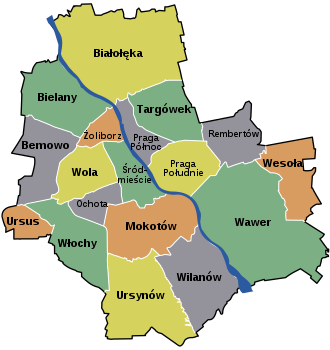Warsaw
![]()
Warszawa is a redirect to this article. For other meanings, see Warszawa (disambiguation).
![]()
This article is about the town. See also: Wahrschau (disambiguation) or Warchau.
Warsaw (Polish Warszawa [varˈʂava] ![]() , Yiddish וואַרשע Warsche) has been the capital of Poland since 1596 and is the country's largest city in terms of area and most populous with over 1.75 million inhabitants. As one of the most important transportation, economic, and commercial centers of Central and Eastern Europe, Warsaw enjoys great political and cultural importance. The city is home to numerous institutions, universities, theatres, museums and monuments.
, Yiddish וואַרשע Warsche) has been the capital of Poland since 1596 and is the country's largest city in terms of area and most populous with over 1.75 million inhabitants. As one of the most important transportation, economic, and commercial centers of Central and Eastern Europe, Warsaw enjoys great political and cultural importance. The city is home to numerous institutions, universities, theatres, museums and monuments.
Situated on both sides of the Vistula River (pln. Wisła) in Mazowieckie Voivodeship, it is the centre of the second largest agglomeration in Poland with about 3.5 million inhabitants. The city is divided into 18 districts, of which Śródmieście is the city centre and the UNESCO World Heritage Site of the reconstructed Old Town of Warsaw.

Castle Square in Warsaw
Name origin
According to popular tradition, Warszawa was originally a remote little fishing settlement on the banks of the Vistula. It is said to have been founded by the poor fisherman Warsz and his wife Sawa. According to the tale, Sawa was a mermaid who lived in the river (see Warsz's coat of arms) and fell in love with the fisherman.
Warsaw was first mentioned in 1241 in the Latin formula of a deed of donation (actum et datum Varschevie, i.e. "decreed and issued at Warsaw"), later medieval names include Warseuiensis (1321, Latin adjective), Varschewia (1342) and Warschouia (1482).
The etymology of the toponym is unclear. The most common hypothesis, favoured among others by Aleksander Brückner, is that the name of the town goes back to the genitive form of the proper name Warsz and thus means something like "[village/estate] of Warsz"; however, this first name itself is hardly documented and its derivation is uncertain, possibly it is a short form of Warcisław. The presumed owner and eponym of the settlement may have been a property owner in the area of today's Solec and Mariensztat districts and may have been a member of the noble family of Rawa or Rawicz.
Other authors assume a Baltic origin of the name, whereby a whole series of etyma offer themselves for comparison, for example the adjective *virš-ī'n- "upper" (cf. Lithuanian viršùs "height, peak, summit"); according to Simas Karaliūnas', Warszawa rather goes back to a Lithuanian Ãpvaršuva, which is supposed to mean "place, with duty of hospitality [to the visiting king]" (cf. Lithuanian apvaišinti, "to entertain all") and is also supposed to have given rise to the name of the royal estate Opvoišovo near Pajūris in Tauroggen.
The city's official name today is Miasto stołeczne Warszawa ("The Capital City of Warsaw"). The inhabitants of Warsaw are called Warsovians - in Polish Warszawiak, Warszawianin (male), Warszawianka (female), Warszawiacy and Warszawianie (plural).
Geographical position
Warsaw is located on the middle Vistula River, in the glacial valley of the Vistula River, and on the Middle Mazovian Depression at an average altitude of 100 meters above sea level. The city spreads out on both sides of the Vistula and is located about halfway between the Carpathian Mountains and the Baltic Sea - it is about 350 km each. The historic city centre is located on the left, western bank of the Vistula on the elongated Vistula cliff Skarpa Wiślana, which rises relatively steeply about 15 to 30 metres above the Vistula. One of the first bridges in Europe, several hundred metres long, connected the two banks as early as the 16th century. This favoured the expansion of the city development to the right bank of the Vistula, which has always been called Praga. In the city area there are several glacial moraine hills as well as man-made hills. The Vistula River is navigable in the Warsaw area. The city has the inland port of Żerań on the right bank of the Vistula. However, shipping traffic is limited to smaller ships and boats, as the river depth often does not exceed three meters.
Climate
Warsaw is located in the transition zone from maritime to continental climate. The average annual temperature is 8.5 °C. The coldest month is January with an average temperature of -1.9 °C and the warmest is July with 19 °C. Summers are warm to hot, winters are cool and sometimes freezing cold. The sum of annual precipitation does not exceed 550 mm. A thick layer of snow is not uncommon in the winter months and the waters in the parks and the Vistula can freeze over completely.
| Warsaw (data from 2015 to 2020) | ||||||||||||||||||||||||||||||||||||||||||||||||
| Climate diagram | ||||||||||||||||||||||||||||||||||||||||||||||||
| ||||||||||||||||||||||||||||||||||||||||||||||||
| Climate data Warsaw
Source: DWD, data: 2015-2020, except sunshine hours from October to December: 2015-2019 | |||||||||||||||||||||||||||||||||||||||||||||||||||||||||||||||||||||||||||||||||||||||||||||||||||||||||||||||||||||||||||||||||||||||||||||||||||||||||||||||||||||||||||||||||||||||||||||||||||||||||||||||
| Warsaw (data from 1961 to 1990) | ||||||||||||||||||||||||||||||||||||||||||||||||
| Climate diagram | ||||||||||||||||||||||||||||||||||||||||||||||||
| ||||||||||||||||||||||||||||||||||||||||||||||||
| Climate data Warsaw
Source: DWD, data: 1961-1990, except rainy days: 1931-1960, humidity: 1951-1960 | |||||||||||||||||||||||||||||||||||||||||||||||||||||||||||||||||||||||||||||||||||||||||||||||||||||||||||||||||||||||||||||||||||||||||||||||||||||||||||||||||||||||||||||||||||||||||||||||||||||||||||||||||||||||||||||||||||||||||||||||||||||||||||||||||||||||||||
City breakdown
Since the last administrative reform in 2002, Warsaw is once again a unified municipality, which at the same time has the status of a district (Polish: powiat). This status is roughly comparable to a district-free city in Germany. Previously, Warsaw was a relatively loose municipal association consisting of several independent municipalities (gminy). Now the city is divided into 18 boroughs (dzielnice), which are quite subordinate to a city-wide administration. Most of the new districts were created from the old municipalities, but with two exceptions:
- The old municipality of Centrum was dissolved and divided into seven districts. Here one returned to the division and naming that had existed until the beginning of the 1990s and which largely originated from pre-war times.
- The former suburban municipality of Wesoła was incorporated when the administrative reform came into force and now forms the district of the same name in the city of Warsaw.
The following are the current districts of Warsaw in numbers (as of 2014):
| Name | Area in km² | Population | Population density in ew./km² |
| Bemowo | 25,0 | 118.057 | 4722 |
| Białołęka | 73,0 | 109.062 | 1494 |
| Bielany | 32,3 | 131.934 | 4084 |
| Mokotów | 35,4 | 218.911 | 6184 |
| Ochota | 9,7 | 84.280 | 8688 |
| Praga-Południe | 22,4 | 178.309 | 7960 |
| Praga-Północ | 11,4 | 67.279 | 5901 |
| Rembertów | 19,3 | 23.812 | 1233 |
| Śródmieście | 15,6 | 120.091 | 7698 |
| Targówek | 24,2 | 123.677 | 5110 |
| Ursus | 9,4 | 56.490 | 6009 |
| Ursynów | 43,8 | 148.385 | 3387 |
| Wawer | 79,7 | 72.921 | 915 |
| Wesoła | 22,6 | 24.073 | 1065 |
| Wilanów | 36,7 | 30.703 | 836 |
| Włochy | 28,6 | 39.940 | 1396 |
| Wola | 19,3 | 138.462 | 7174 |
| Żoliborz | 8,5 | 49.056 | 5771 |
| Total | 516,7 | 1.735.442 | 3356 |

Administrative division of Warsaw since 2002
Search within the encyclopedia